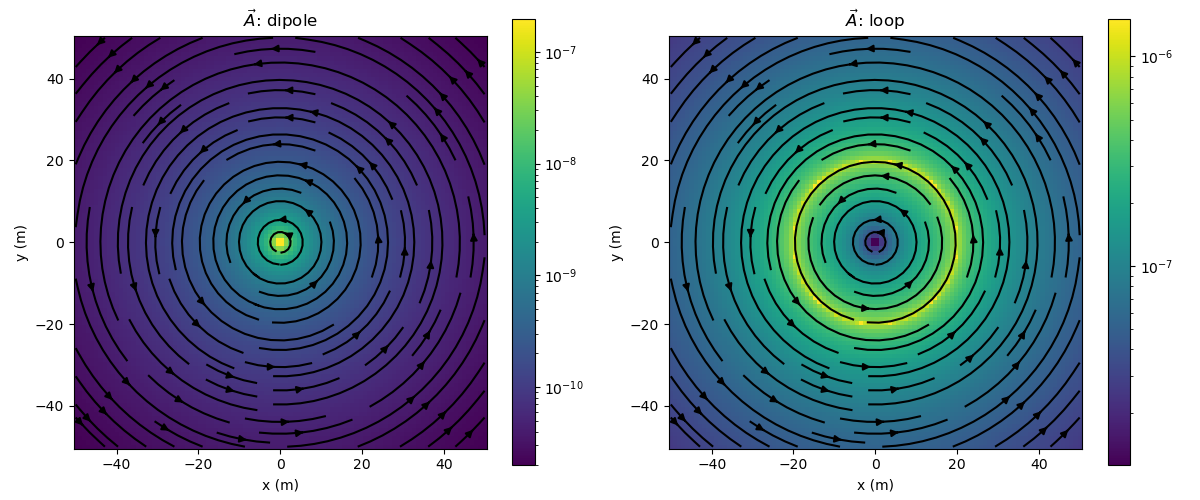Note
Go to the end to download the full example code.
Magnetostatic Vector Potentials: Dipole and Loop Sources#
In this example, we plot the vector potential for a dipole and a loop source in a wholespace.
We can vary the magnetic permeability of the wholespace, location and orientation of the sources. For the dipole source, we can vary the moment, and for the loop source, we can vary the radius and current through the loop.
- author:
Lindsey Heagy (@lheagy)
- date:
June 6, 2018
Setup#
define the location orientation and source, physical properties of the wholespace and source parameters
Magnetostatic Dipole and Loop#
Here, we build the geoana magnetic dipole in a wholespace and circular loop
in a wholespace using the parameters defined above.
For a full list of the properties you can set on a dipole, see the
geoana.em.static.MagneticDipoleWholeSpace docs and for the
circular loop source, see the
geoana.em.static.CircularLoopWholeSpace docs
dipole = static.MagneticDipoleWholeSpace(
mu=mu, location=location,
orientation=orientation , moment=moment
)
loop = static.CircularLoopWholeSpace(
mu=mu, location=location,
orientation=orientation, current=current,
radius=radius
)
Evaluate vector potential#
Next, we construct a grid where we want to plot the vector potential and evaluate
and define plotting code to plot an image of the amplitude of the vector field / flux as well as the streamlines
def plot_amplitude(ax, v):
v = spatial.vector_magnitude(v)
plt.colorbar(
ax.pcolormesh(
x, y, v.reshape(len(x), len(y), order='F'), norm=LogNorm()
), ax=ax
)
ax.axis('square')
ax.set_xlabel('x (m)')
ax.set_ylabel('y (m)')
# plot streamlines
def plot_streamlines(ax, v):
vx = v[:, 0].reshape(len(x), len(y), order='F')
vy = v[:, 1].reshape(len(x), len(y), order='F')
ax.streamplot(x, y, vx.T, vy.T, color='k')
Create subplots for plotting the results. Loop over frequencies and plot the electric and magnetic fields along a slice through the center of the dipole.
fig, ax = plt.subplots(1, 2, figsize=(12, 5))
# plot dipole vector potential
plot_amplitude(ax[0], a_dipole)
plot_streamlines(ax[0], a_dipole)
# plot loop vector potential
plot_amplitude(ax[1], a_loop)
plot_streamlines(ax[1], a_loop)
# set the titles
ax[0].set_title("$\\vec{A}$: dipole")
ax[1].set_title("$\\vec{A}$: loop")
# format so text doesn't overlap
fig.tight_layout()
plt.show()

Total running time of the script: (0 minutes 0.821 seconds)